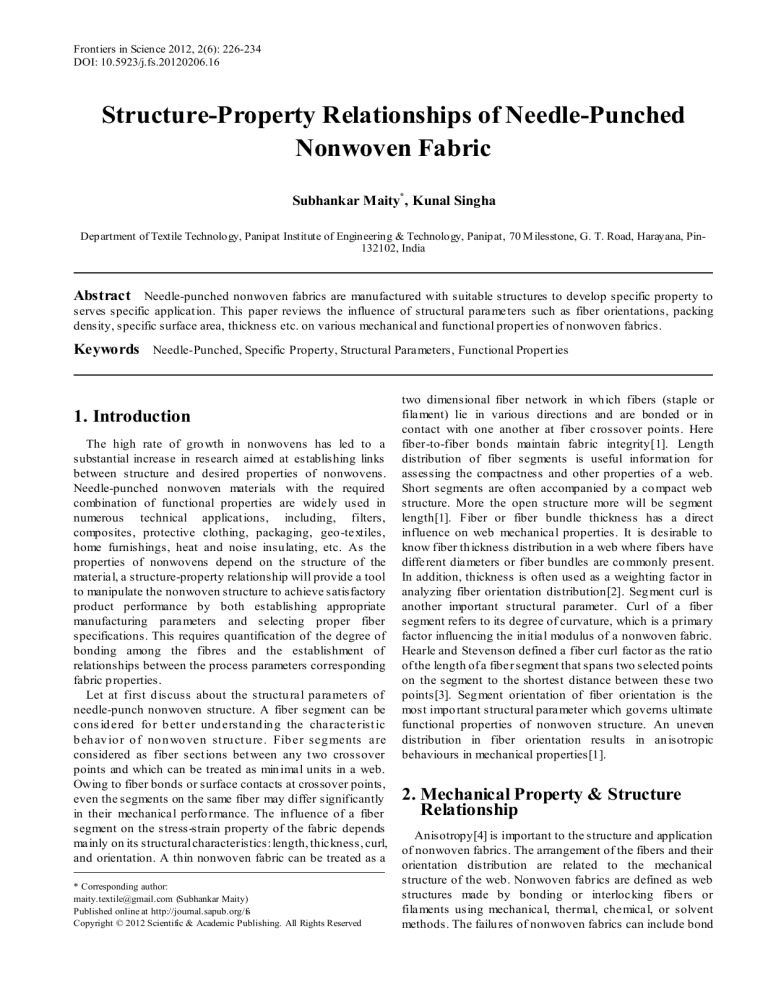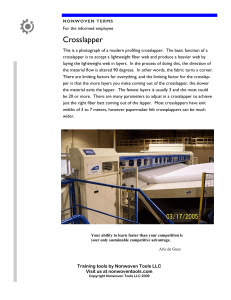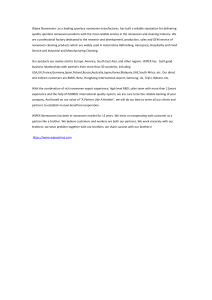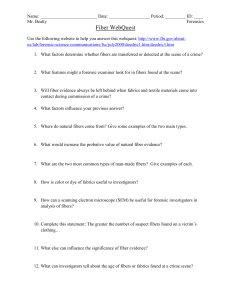Needle-Punched Nonwoven Fabric Structure-Property Relationships
advertisement

Frontiers in Science 2012, 2(6): 226-234 DOI: 10.5923/j.fs.20120206.16 Structure-Property Relationships of Needle-Punched Nonwoven Fabric Subhankar Maity* , Kunal Singha Department of Textile Technology, Panipat Institute of Engineering & Technology, Panipat, 70 M ilesstone, G. T. Road, Harayana, Pin132102, India Abstract Needle-punched nonwoven fabrics are manufactured with suitable structures to develop specific property to serves specific applicat ion. This paper reviews the influence of structural parame ters such as fiber orientations, packing density, specific surface area, thickness etc. on various mechanical and functional propert ies of nonwoven fabrics. Keywords Needle-Punched, Specific Property, Structural Parameters, Functional Propert ies 1. Introduction The high rate of gro wth in nonwovens has led to a substantial increase in research aimed at establishing links between structure and desired properties of nonwovens. Needle-punched nonwoven materials with the required combination of functional properties are widely used in numerous technical applicat ions, including, filters, composites, protective clothing, packaging, geo-textiles, home furnishings, heat and noise insulating, etc. As the properties of nonwovens depend on the structure of the material, a structure-property relationship will provide a tool to manipulate the nonwoven structure to achieve satisfactory product performance by both establishing appropriate manufacturing parameters and selecting proper fiber specifications. This requires quantification of the degree of bonding among the fibres and the establishment of relationships between the process parameters corresponding fabric p roperties. Let at first d iscuss about the structu ral parameters of needle-punch nonwoven structure. A fiber segment can be cons id ered fo r b ett er und erstand in g the characterist ic b eh av io r o f no n wo ven st ru ct u re. Fib er seg ments are considered as fiber sect ions bet ween any t wo crossover points and which can be treated as min imal units in a web. Owing to fiber bonds or surface contacts at crossover points, even the segments on the same fiber may differ significantly in their mechanical perfo rmance. The influence of a fiber segment on the stress-strain property of the fabric depends mainly on its structural characteristics: length, thickness, curl, and orientation. A thin nonwoven fabric can be treated as a * Corresponding author: maity.textile@gmail.com (Subhankar Maity) Published online at http://journal.sapub.org/fs Copyright © 2012 Scientific & Academic Publishing. All Rights Reserved two dimensional fiber network in wh ich fibers (staple or filament) lie in various directions and are bonded or in contact with one another at fiber crossover points. Here fiber-to-fiber bonds maintain fabric integrity[1]. Length distribution of fiber segments is useful informat ion for assessing the compactness and other properties of a web. Short segments are often accompanied by a co mpact web structure. More the open structure more will be segment length[1]. Fiber or fiber bundle thickness has a direct influence on web mechanical properties. It is desirable to know fiber th ickness distribution in a web where fibers have different diameters or fiber bundles are co mmonly present. In addition, thickness is often used as a weighting factor in analyzing fiber orientation distribution[2]. Seg ment curl is another important structural parameter. Curl of a fiber segment refers to its degree of curvature, which is a primary factor influencing the in itial modulus of a nonwoven fabric. Hearle and Stevenson defined a fiber curl factor as the rat io of the length of a fiber segment that spans two selected points on the segment to the shortest distance between these two points[3]. Seg ment orientation of fiber orientation is the most impo rtant structural parameter which governs ultimate functional properties of nonwoven structure. An uneven distribution in fiber orientation results in an isotropic behaviours in mechanical properties[1]. 2. Mechanical Property & Structure Relationship Anisotropy[4] is important to the structure and application of nonwoven fabrics. The arrangement of the fibers and their orientation distribution are related to the mechanical structure of the web. Nonwoven fabrics are defined as web structures made by bonding or interlocking fibers or filaments using mechanical, thermal, chemical, or solvent methods. The failu res of nonwoven fabrics can include bond 227 Frontiers in Science 2012, 2(6): 226-234 failure, fiber rupture, and fibre slippage[5]. Generally, fibers in the web are oriented in various directions following a random or known statistical distribution. The mechanical properties of nonwoven fabrics depend on raw materials, fiber fineness, fiber length, fiber arrangement, and structural differences resulting fro m different manufacturing processes[6-7]. Thus, test has been conducted to see the effect of such fiber arrangements on the tensile strength, tearing strength, and bursting strength of the nonwoven fabrics. 2.1. Infl uence of Fi ber Arrangement on Tensile Strength Fiber orientation has a big influence on the tensile strength of the nonwoven material. Because the fibers were arranged along the machine direction (vert ical d irection) by the conventional method of manufacturing nonwoven fabrics, tensile strength was best in the vertical direct ion. The tensile strength of the parallel web or rando m web decreased with increasing angle of cut of the specimen for strength measurement. Elongation was higher in the horizontal direction or cross direction. It was also reported that the coefficient of variation of the parallel web was below 10% for tensile strength. Due to uneven thickness, the variation coefficient of the random webs was above 10%; with the rando m arrangement, there were more fibers in the horizontal direction than in the vertical d irection. The tensile strength of the horizontal direction increased, but that of the vertical direction decreased[2]. 2.2. Infl uence of Fi ber Arrangement on Tearing Strength A study was conducted for accessing the tearing strength of the nonwoven material and the influence of fiber arrangement on it also reported[2]. It was reported that both for parallel and random webs the tearing strength in horizontal direction is more than that of the vertical direction for both the method. 2.3. Infl uence of Fi ber Arrangement on Bursting Strength The bursting strength in the random webs was lower than that in the parallel webs. One possible explanation could be that the fiber arrangement in the random webs was anisotropic, so there were mo re interlacing spots and voids in these webs. The failure extended fro m these voids to the perimeter under breaking conditions. The bursting strength in the parallel webs was better[2]. 2.4. Air Permeability& Structure Rel ationshi p Permeability[8] affects criteria such as sound absorption, filtration, and thermal p roperties. The pressure gradient through a bed of porous material is a function of fluid viscosity, flu id and material densities, rate of fluid flo w, and material porosity. When considering the flow through porous materials, the shape, arrangement, and size d istribution of voids through which flow must occur are extremely important. In fact, there is no simp le correlation between permeab ility and porosity because of the strong dependence of flo w rate on the width, shape, and tortuosity of the conducting channels[9-10]. Tortuosity, the rat io of effective channel length and sample thickness, is an important factor in determin ing flow through nonwoven materials[11-12]. The researchers had been determined and discussed the experimental and theoretical air permeab ility of mu ltilayer, glass/ceramic nonwoven samples. The Frazier permeab ility tester was used for experimental measurements. Theoretical permeab ility was determined using a modified Kozeny equation[8] along with weighted averages for fiber diameter and density. The fabric structure was varied by changing the number of glass and ceramic webs, and by varying the number of needle barbs used in needle punching the samples. Figure 1. Comparison of experimental and Theoretical permeability[8] Subhankar M aity et al.: Structure-Property Relationships of Needle-Punched Nonwoven Fabric As shown in figure 1, the theoretical permeability was lower than the experimental permeab ility in all cases. According to the author this difference in permeability is mainly associated with the non random distribution of fibers, and this lack of randomness is due to two factors. First, needled nonwovens have areas that have not been needled and where the fibers are still rando mly oriented. However, the areas where the needle penetrates the fibers are not considered to be randomly distributed. In these areas, a channel may be formed that reduces tortuosity, thus increasing permeability. A second factor causing the difference in experimental and theoretical permeability is the non-uniform weight/thickness ratio of the experimental fabric, which is due to the non-uniformity of the ceramic web. Produced by melt b lowing, the ceramic web has thick and thin spots throughout. The thin spots are open places that allow mo re airflo w. It is believed that non-uniformity in the ceramic web is the major factor that causes the experimental permeab ility to be higher than the theoretical permeability. 3. Thermal Conductivity & Structure Relationship One of the[13] major applicat ions for nonwoven fibrous systems is as thermal insulation materials. Because of savings in both space and weight, lo w-density insulating nonwoven materials are being used in consumer appliances, homes, and automobiles, in aircraft, and in industrial process equipment. Heat flu x passing through a participating med iu m may in general be represented by several mechanis ms: free and forced convection, conduction through solid fibers, and conduction through air in the inter fiber spaces, and radiation[14]. Thermal conductivity is one mode of heat transfer in which an energy exchange takes place fro m the higher temperature to lower temperature. Based on the Fourier[15] heat transfer equation, Q AKtc T AKtc dT d 228 The governing equation for effective thermal conductivity is K eff Q 1 S T T 1 2 (2) where Ke ff = elect ive thermal conductivity (W/ m°C), Q = heat generated by the electrical source (W), and Q = (N)(EI), S = main heater surface area (0.00835 m2 ), λ = thickness of the upper and lower samp les being tested (m), ΔT temperature gradient (°C), E = voltage reading at switch position 22 ( 1 mV = I volt), I = current reading at switch position 23 ( mV = 0.1 amp ), and N = power correction factor determined experimentally by Holo metrix to account for s mall systematic errors in the power measurement. The sample was considered to be at steady state when the temperature d ifference between the hot and cold sides was constant for a 30 minute interval. It was reported that temperature difference is highest for each individual fabric structure when n ine barbs are used to bond the fabric. The overall increase in T, which shows less heat transfer through the samples (or otherwise more heat blocked), results fro m an increase in packing density. A higher packing density increases tortuosity, and less heat flows through the channels. The nine-barb, G-C-G-C-G sample is the only exception to this trend. When considering the characteristics of this sample, no clear exp lanation arises for this discrepancy. (1) Where Ktc = thermal conductivity of the sample[w/(m°C)], A = cross-sectional area of the sample (m2 ), ΔT = temperature d ifference (°C), Q = heat flow rate (w), λ= thickness of the sample (m), and ΔT/ λ = gradient of temperature in the X direction (°C/ m). A number o f different methods and apparatuses are available for determining effective thermal conductivity[16-19]. Measuring effective thermal conductivity Temperature d ifference was measured[4] per unit thickness and thermal conductivity of the samples were measured using the Holo metrix guard hot p late (model GHP-200), designed to accommodate material samp les up to 20.32 cm (8 inches) in d iameter and 5.08 cm (2 inches) thick. Any test temperature between -180°C and +650°C can be reached, and test environments of air, vacuu m, or inert gas can be used. Figure 2. Effect of fabric structure on temperature difference at an applied temperature of 400°C[13] The fabric weight is h igher, while thickness, pore size, and porosity are lower than for the three-barb and six barb structures. This means that the nine-barb structure is more packed, thus having higher tortuosity or a lower mean free path, which should result in more heat being blocked. Also, as revealed in figure 2, as the nu mber of glass webs increased, T at 400°C increased for all cases. Though glass fibers have high thermal conductivity, when they are p laced in a nonwoven structure where the tortuosity is increased, i.e., mean free path is reduced, the conductivity will be reduced 229 Frontiers in Science 2012, 2(6): 226-234 due to increased forward and backward reflection of the radiation co mponent. Also as the number of ceramic webs increases, T at 400°C increases. This again is due to the decrease in mean free path, resulting in a higher reflection of the radiation component. Also, the increase in T when the number of ceramic webs increases is much higher than that observed when glass webs increase. Ceramic fibers have a lower thermal conductivity than glass fibers. Also, the fibers used in the ceramic webs were slightly finer than the glass’ fibers, causing ceramic webs to have higher packing densities and thus a higher tortuosity. Finally, ceramic fibers have a higher glass transition temperature than glass fibers; 145ºC and 750°C, respectively. Thus, more time is required for ceramic fibers to heat up and radiate energy, which causes an increase in T, the amount of heat blocked. 3.1. Effect of Fabric Structure on Coefficient of Thermal Conducti vity The effect of the nu mber of barbs and the fiber content on the effective thermal conductivity (Keff) has been discussed following. All d iscussion is based on sample behavior at steady state. Keff is determined fro m equation and is a function of flo w rate, T and thickness. Effect of number o f barbs Figure 3. Effect of no. of barbs on effective thermal conductivity[13] Figure 3 shows that as the number of barbs increases from three to six, Keff decreases, but when the number of barbs increases further from six to nine, Ke ff increases slightly. In considering fabric p roperties, two trends can explain the initial decrease in Ke ff with an increased number of barbs. In the G-C-G and GG-C-G-C-GG Structures, weight and pore size increase while the thickness decreases . When the weight increases with decreasing thickness sample beco mes mo re packed. This means that the tortuosity increases or the mean free path for photons decreases. In the GG-C-GG and G-C-G-C-G structures, weight and thickness decrease while pore size increases as the number of barbs increases from three to six. In the GG-C-GG structure, there is a small decrease in weight compared to the decrease in thickness, i.e., the six-barb structure is more packed than the three-barb structure. This again means that Keff will decrease. In the G-C-G-C-G structure, there is a very small decrease in weight, thickness, and pore size, which leads to only a s mall decrease in Ke ff. In d iscussing the increase in Keff when moving fro m six to nine barbs, two factors must be considered. In the GG-C-GG, G-C-G-C-G, and GG-C-G-C-GG structures, the weight to thickness ratio using nine barbs is higher than when six barbs are used, and the pore sizes for the nine-barb structures are less than that of the six-barb structures. This implies that the nine-barb structures are more packed than the six-barb structures. However, the weight-to thickness ratio of the G-C-G structure is higher for the six-barb structure than for the nine-barb structure. The pore size of the nine-barb structure is bigger than that of the six-barb structure. This implies that the nine-barb structure is more open, and thus the rate of heat transfer by radiation increases. Effect of number o f layers Increasing the number of glass webs always causes an increase in Ke ff, but this is not the expected trend. As the number of glass webs increases, Keff should decrease. The expected decrease in effective thermal conductivity when glass, with a high conductivity, used in the web form is associated with an increased scattering of photons. In comparing the G-C-G and GG-C-GG structures for all barbs, we see that Keff increases for the GG-C-GG structures. As shown in Equation 2, Ke ff is a function of several factors, including heat flo w Q, thickness L, and temperature difference ∆T. There are several e xp lanations for the unexpected increase in Keff. There is a slight increase in the mean ∆T, wh ich should cause a decrease in Keff. At the same time, there is an increase in thickness, which, assuming all other factors to be constant, should increase in Ke ff. Though ∆T is not constant, the slight increase in ∆T (<50°C) is not enough to counter the effect of increasing the sample thickness. Finally, there is a slight increase in Q, which makes only a negligible increase in Ke ff. If the problem is associated with increased thickness, then for a fixed number of needle barbs, an increase in nu mber of g lass webs results in increased thickness, i.e., a more packed structure. The increased packing causes an increase I conduction and thus increase thermal conductivity. Again, this is not the expected trend and may be a result of increased packing density leading to increased thermal conductivity[13]. 4. Moisture Diffusivity and Structure Relationship Fiber volu me fraction and shape coefficient are the most important structural parameters affecting water vapor diffusivity through non hydrophilic nonwoven fabrics. Water vapor diffusivity decreases with increasing fiber volu me fraction and decreases as the flatness of the fiber cross section increases[20]. 4.1. Effects of Fi ber Vol ume Fraction Fiber volu me fraction is playing a strong role in controlling moisture diffusion through fibrous structures [20]. Subhankar M aity et al.: Structure-Property Relationships of Needle-Punched Nonwoven Fabric Figure 4 shows that for melt blown nonwovens, water vapor diffusivity decreases with increasing fiber volu me fraction. But in many cases, moisture vapor transmission cannot be adequately exp lained solely on the basis of fiber volu me fraction. This is because of the comp lex interactions between fiber volume fraction and other parameters including fiber shape coefficient and the kind of fiber used in the nonwoven construction. The differences between semi-permeable, permeab le, and h ighly permeab le nonwoven barrier fabrics are illustrated in Figure 5. 4.2. Effects of Shape Coefficient Beside fiber vo lu me fract ion, fiber shape factor is key parameter controlling mo isture permeability of nonwoven fabric. It was reported that water vapor d iffusivity is inversely proportional to the fiber shape coefficient. This means that flat fibers provide more cover than round or trilobal fibers. Higher fiber cover reduces mo isture penetration[20]. 230 4.3. Effects of Fabric Thickness and Fi ber Di ameter Fabric thickness and fiber fineness affect water vapor diffusivity because these variables control optical porosity. The finer the component fibers, the more will be the filament separation and the higher the cover factor. Thicker fabrics also have lower optical porosities as is shown in figure 6. This paper[20] shows, however, that the effects of fabric thickness and fiber fineness on total water vapor diffusivity are s mall. Figure 7 shows the relationship between water vapor diffusivity and fiber fineness. Unfortunately, because of the interaction with fiber volu me fract ion, this comparison does not give enough information about the effects of fiber fineness. However, this co mparison shows that there is litt le difference in the water vapor d iffusivity of nonwoven samples made with 2.5 μm fibers ( M 1 ~ M9) and melt blown samples containing fibers in the 10 μm range (M 10 ~ M 18 ). Figure 4. Relationships between water vapor diffusivity and fiber volume fraction of melt blown webs[20] Figure 5. Relationships between water vapor diffusivity and fiber volume fraction of barrier nonwovens[20] 231 Frontiers in Science 2012, 2(6): 226-234 Figure 6. Relationship between fabric thickness and water vapor diffusivity[20] Figure 7. Relationship between water vapor diffusivity and fiber fineness[20] 5. Acoustical Behavior and Structural Relationship Nonwoven fabrics[21] are ideal materials for use as acoustical insulation products because they have high total surface. The surface area of the fabric is directly related to the denier and cross sectional shape of the fibers in the fab ric. Smaller deniers yield more fibers per unit weight of the material, higher total fiber surface area and g reater possibilit ies for a sound wave to interact with the fibers in the structure. Another important parameter is the packing density of the fibers in the nonwoven material. More fibers per unit volume at the same fabric thickness yield greater possibilit ies for sound waves to interact with the fibers. To obtain an indication of the effect of fiber shape on acoustical properties, needle punched nonwoven fabrics made fro m 3 and 15 den polyester round fibers, 15 den polyester trilobal fibers, and 3 and 15 den polyester expanded surface area fibers (4DG) with comparab le thicknesses and densities were selected. To obtain an indication of the effect of fiber denier on acoustical properties, fabrics made fro m 3 and 15 den polyester rounds, 15 den polyester trilobal, and 3 and 15 den polyester 4DG fibers with comparable thicknesses and densities were selected. As shown in Figure 8, needlepunched nonwoven test materials made fro m 3 den round fibers were better sound insulators than test materials made fro m 15 den round polyester fibers. Results showed that the difference in transmitted sound between test materials made fro m 3 den round polyester fibers and 15 den round polyester fibers did not change with density for each fabric density level. Sound insulation of nonwoven test material made fro m 3 denier round fibers was much better than the sound insulation of nonwoven test material made fro m 15 den round fibers. The results for trilobal and 4DG shapes showed the same trend Subhankar M aity et al.: Structure-Property Relationships of Needle-Punched Nonwoven Fabric with round shape fiber, as shown in Figure 9. The acoustical insulation comparison for the nonwoven test materials made fro m 15 den round-, trilobal- and 4DG shaped fibers was used to study the effect of expanded surface area. As shown in Figure 9, the needlepunched nonwoven fabrics made fro m 4DG and trilobal fibers had better sound insulation results than nonwoven fabrics made fro m round fibers. The reason for this result may be because of the effect of surface area in the fabric. 4DG fibers had appro ximately three times mo re surface area than round fibers. Higher surface area in the nonwoven fabric increased the possibility of the sound wave interaction with the fibers and resulted in more effective sound deadening in the nonwoven fabric. Fro m the results shown in Figures 8 and 9, it could be concluded that surface area affected sound insulation properties of nonwoven fabrics positively. To obtain an indication of the effect of fabric density on acoustical properties, nonwoven fabrics with comparab le densities at the same thicknesses and weights were selected. An acoustical insulation comparison for all fibers at five fabric density levels is shown in Figure 10. At a fabric density level of appro ximately 1.18 g/cm3, fibers were 232 mostly crushed and there was no difference in the acoustical behavior of the test materials. The material was no longer a needlepunched nonwoven fabric; it was mo re like a polyester sheet film. The surface was very smooth and, therefore, most of the sound wave was reflected instead of moving into the material. Th is property resulted in sound transmitted values that were much lo wer fo r the polyester sheet film than nonwoven fabrics. Increasing sound reflect ion rather than increasing sound absorption is not an effective way to insulate the sound because there will be noise pollution on the environment with increasing reflection value of the sound wave. As indicated in Figure 10, needlepunched nonwoven fabrics with higher densities yielded better sound insulation properties than nonwoven fabrics at lower densities. Therefore, we concluded that fabric density affected the sound insulation property of the nonwoven fabrics positively. The effect of fabric density on the transmitted sound data for needlepunched nonwoven fabrics made fro m different deniers and different shapes was consistent with the results, as shown in Figure 10. Figure 8. Transmitted sound results for needlepunchd nonwoven fabrics made from 3 and 15 denier fibres with 0.16 g/cc density[21] Figure 9. Transmitted sound results for needlepunchd nonwoven fabrics made from15 denier 4DG, trilobal and round fibres with 0.27 g/cc density[21] 233 Frontiers in Science 2012, 2(6): 226-234 Figure 10. Transmitted sound results for needlepunchd nonwoven fabrics made from 3 denier 4DG fibres with various densities 0.09g/cc, 0.16 g/cc, 0.27 g/cc, 0.44 g/cc and 1.18 g/cc[21] 6. Conclusions REFERENCES The tensile strength of the parallel web or rando m web decreases with increasing angle o f cut d irection of the specimen. Elongation is irregular and best in the horizontal direction or cross direction. Both for parallel and random webs tearing strength of horizontal direction are more than that of the vertical direct ion for both the method. The bursting strength in the parallel webs is better than that of the cross web. When tortuosity reduces air permeab ility increases. As the number of barbs in needleunched nonwoven increases fro m three to six, Ke ff decreases, but when the number of barbs increases further fro m six to n ine, Keff increases slightly. Water vapor diffusivity decreases with increasing fiber volu me fract ion and decreases as the flatness of the fiber cross section increases . Smaller deniers yield more fibers per unit weight of the material, higher total fiber surface area and greater possibilities for a sound wave to interact with the fibers in the structure. More fibers per unit volume at the same fabric thickness yield greater possibilit ies for sound waves to interact with the fibers. needlepunched nonwoven fabrics with higher densities yield better sound insulation properties than nonwoven fabrics at lower densities. [1] Xu, B. and Ting, T. (1995). M easuring Structural Characteristics of Fiber Segments in Nonwoven Fabrics. Textile Research Journal, 65: 41-48. [2] Lin, H., Lin. X., Hong, Z., and Lei, H. C. (2003). Effect of Fiber Arrangement on the M echanical Properties of Thermally Bonded Nonwoven Fabrics. Textile Research Journal, 69: 917-920. [3] M ohammadi, M . and Lee-Banks, P. (2002). Air Permeability of M ultilayered Nonwoven Fabrics. Textile Research Journal, 32: 613-711. [4] M ohammadi, M and Lee-Banks, P. (2003). Determining Effective Thermal Conductivity of M ultilayered Nonwoven Fabrics. Textile Research Journal, 79: 802-808. [5] Woo, S.S., Shalev, I. and Barker, L.R. (1994). Heat and M oisture Through Nonwoven Fabrics (Part 2 M oisture Diffusivity). Textile Research Journal, 32: 190-197. [6] Tascant, M . and Vaughn, A.E. (2008). Effect of Total Surface Area and Fabric Density on Acoustical Behaviour of Needle Punch Nonwoven Fabric. Textile Research Journal, 78: 289-296. [7] Huang, X.C., and Bresee, R.R., (1993). Characterizing Nonwoven Web Structure Using Image Analysis Techniques, Part II: Fiber Orientation Analysis in Thin Webs, INDA. Journal of Nonwoven Research, 2: 14-21. [8] Hearle, J. W. S., and Stevenson, P. J., (1963). Nonwoven Fabric Studies, Part III: The Anisotropy of Nonwoven Fabrics, Textile Research Journal, 33: 877-888. [9] M uller, D., (1989). Random orientation in case of card nonwoven, Edana’s 1989 U.K. Nonwoven Symposium, 17-36. Abbreviations G-C-G GG-C-GG G-C-G-C-G GG-C-G-C-GG Glass fiber – Ceramic – Glass fiber web arrangement Double Glass fiber – Ceramic - Double Glass fiber web arrangement Glass fiber – Ceramic – Glass fiber – Ceramic – Glass fiber web arrangement Double Glass fiber – Ceramic – Glass fiber – Ceramic – Double Glass fiber web arrangement [10] Pourdeyhimi, B., Ramanathan, R., and Dent, R., (1996). M easuring Fibre Orientation in Nonwovens, Part I: Simulation, Textile Research Journal, 66: 713-722. [11] Watanabe, A., M ila, M ., Takeno, Y., Yokoi, T., & Nakayama, A., (1996). Fatigue Behavior of Aramid Nonwoven Fabrics Under Hot Pres Condition, Part III: Effect of Fabric Structure Subhankar M aity et al.: Structure-Property Relationships of Needle-Punched Nonwoven Fabric on Compressive Behaviors, Textile Research Journal, 66: 669-676. [12] Hillel, A., (1980). Fundamentals of Soil, Physics, Academic Press, NY. [13] Scheidegger, A.E., (1960). The Physics of Flow through Porous M edia, University of Toronto, Toronto, Canada. [14] Piekaar, H.W., and Clarenburg, L.A., (1967). Aerosol Filters&mdash; The Tortuosity Factor in Fibrous Filters, Chemical Engineering Science, 22: 1817-1827. [15] Piekaar, H.W., and Clarenburg. L.A., (1968). Theory of the Pressure Drop Across Single Component Glass Fiber Filters, Chemical Engineering Science, 23: 765-771. [16] M artin, J.R., and Lamb, G.E. R., (1987). M easurement of Thermal Conductivity of Nonwovens Using a Dynamic M ethod, Textile Research Journal, 57: 721-727. [17] Ozisik , M .N., (1985). Heat Transfer, A Basic Approach," M cGraw-Hill, NY. 234 [18] Bapat, S.L., Narayankhedkar, K.G., and Lukose, T.P., (1990). Investigations of M ultilayer Insulation, C ryogenics , 30: 711-719. [19] Holcombe, B., The Thermal Insulation Performance of Textile Fabrics, C.S.I.R.O. Division of Textile Physics, 338 Blaxland Road, Ryde, N. S. W. 2112, Australia. [20] Hust, J.G., Filia, B.J., Hurley, J.A., & Smith, D.R., (1990). An Automated High Temperature Guarded-Hot-Plate Apparatus for M easuring Apparent Thermal Conductivity of Insulations Between 300 and 700 & deg K, Insulation M aterials Testing and Application, ASTM STP 1030, M cElroy and Kimpflen, Eds., American Society for Testing and M aterials, Philadelphia, 710-722, [21] Kourtides, D.A., Pitts, W.C., Araujo, M ., & Zimmerman, R.S., (1988). High Temperature of Ceramic Fibers and Insulations for Thermal Protection of Atmospheric Entry and Hypersonic Cruise Vehicles, SAM PE Quart., 19 (3): 8-19.






